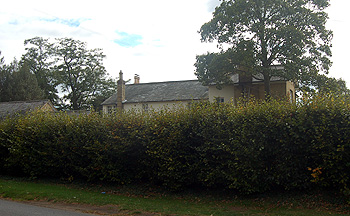
The Old Vicarage seen from Ampthill Road October 2011
The first mention of a vicarage at Silsoe is probably on 21st October 1324. On this date half an acre of land was conveyed by William Atefen to William Jacob and Alice, his wife. The land abutted on the tenement of the chapel at Syvelesho [LJeayes686]. This strongly suggests a residence for a vicar or curate, Silsoe then being part of the parish of Flitton and the chapel being under the care of the Vicar of Flitton.
In 1725 a terrier was made of all the lands belonging to Flitton church; they included the Town House [P12/2/1/1] which was described thus: "A messuage at Silsoe, containing a House, Garden and Barn, being by Estimation half an Acre. Bounded on the East by the Parsonage House & Close, on the South by the Orchard belonging to the George Inn, on the West by the Chappel yard & a Garden belonging to the Town of Silsoe 7 on the North by a Road that leads to his Grace the Duke of Kent's Seat".
In 1763 a letter to Philip Yorke, 2nd Earl of Hardwicke and husband of Marchioness Grey described a school kept by a Mr. Harrison in the chapel [CRT100/27/3]. The letter says: "He heard I was going to repair the vicarage house and wished it might be made fit for his purpose and let to him at an advanced rent". In 1812 Lady Lucas' agent in Silsoe wrote that the Vicar of Flitton intended to have a curate for Silsoe at Easter. Harrison considered it was important that he be a good preacher "in this age and rage for Methodism" [L30/11/112].
Silsoe became a separate ecclesiastical parish in 1846 and thus needed a good sized vicarage for the incumbent. The Old Vicarage still stands on Ampthill Road between Vicarage Road and Fir Tree Road. The house dates to 1845 or earlier (see below). A map of 1828 [L33/9] seems to show a property on the site of the Old Vicarage, but this may have been an annotation added later.
A copy conveyance of 10th February 1846 [L27/62] saw Thomas Philip, 2nd Earl de Grey, who had built the new church in the village in 1830 and 1831, grant land as the site of the vicarage to the Diocese of Ely in return for the advowson of Silsoe church. Bedfordshire lay in the Diocese of Ely from 1837, when it left the Diocese of Lincoln, until 1914 when it transferred to the Diocese of Saint Albans.
The site is described in the deed as: "all that piece of land or ground situate, lying and being in Silsoe aforesaid in the County of Bedford containing by admeasurement half an acre more or less which said piece or parcel of land or ground is bounded on the north by a Cottage and Garden belonging to William Haytread and in the occupation of Yates on the east by an ancient Lane running from the Ampthill Road to West End on the remaining south and west sides by property of James Barnard and is surrounded on the east, south and west sides thereof with a quick hedge". The site included "all that freehold messuage or tenement and outbuildings and premises lately erected and built by George Henry Whitbread the late Owner thereof with the fixtures and appurtenances thereunto belonging".
The Rating and Valuation Act 1925 specified that every building and piece of land in the country was to be assessed to determine its rateable value. The valuer visiting the Vicarage [DV1/C236/98] found that it stood in just under an acre of land. The living was worth £30 per quarter from the Ecclesiastical Commissioners plus about another £4 in fees for marriages etc.
The house comprised a study, a drawing room, a dining room, two kitchens, a scullery and a pantry on the ground floor with five bedrooms, a boxroom and a bathroom above. A greenhouse measuring 18 feet by 9 feet stood outside along with outhouses, a washhouse, a "very small" garage and an earth closet.
An Ordnance Survey map of the early 1970s still shows the Old Vicarage as being the vicarage, the present vicarage not having been built. At the present time [2011] the Parochial Church Council minutes for Silsoe have only been deposited up to 1947 and so it is not possible to say when the vicarage switched to the new house built in Fir Tree Walk which remains the vicarage for Silsoe, Flitton and Pulloxhill at the time of writing.